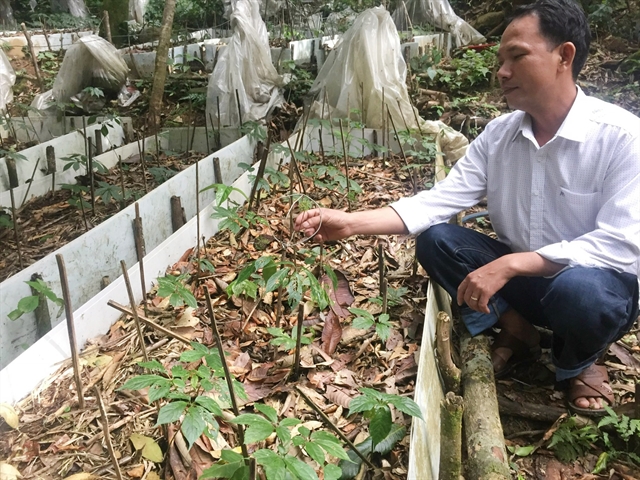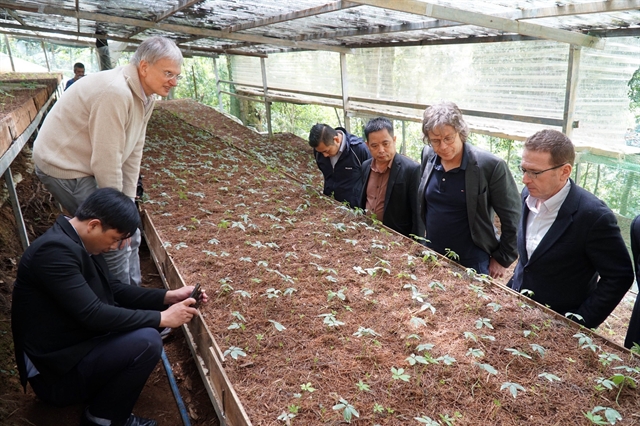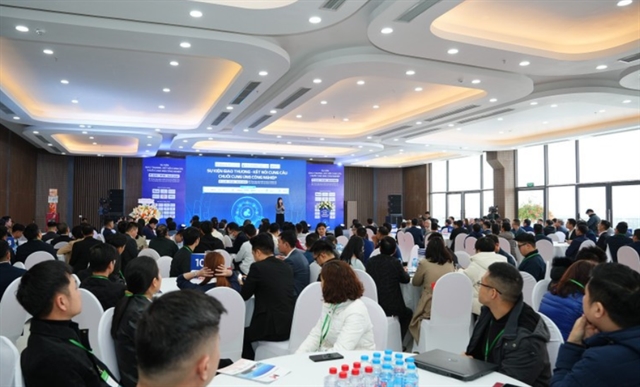 Society
Society

.jpeg) |
| Growing ginseng is one of the solutions to protect forests in Quảng Nam Province. — Photo baotainguyenmoitruong.vn |
QUẢNG NAM — Planting medicinal trees has helped ethnic minorities in Quảng Nam Province to alleviate poverty, improve living standards, and contribute to the protection of forests.
The mountainous area of Quảng Nam Province has a rich natural forest ecosystem for the development of medicinal plants.
Realising that planting ginseng brought high economic efficiency, and increased forest cover, the village elder Bhríu Pố, in Lăng Commune, Tây Giang District, has pioneered growing this precious medicinal herb.
Every year, his family grows about 2,000 ginseng trees, bringing a stable income of VNĐ120 million-VNĐ170 million (US$5,000-7,200).
“Right from the beginning of growing ginseng, my family determined that we wanted to do business to eliminate poverty,” Bhríu Pố, 60 years old, said.
"This plant is easy to sell, and it's not difficult to grow and take care of."
"Its use is also very good for all people and all ages."
“Even more important is to protect the source of rare and precious medicinal plant varieties, to protect the forest, and to have a stable income for growers,” he said.
He has mobilised local people to grow medicinal plants together. “And currently, local people are planting widely, this is the basis for local poverty alleviation.”
In recent years, the Xơ Đăng ethnic minority people in the mountainous district of Nam Trà My have been maintaining and expanding the area of precious medicinal plants such as cinnamon and ginseng.
According to local authorities' statistics, in this mountainous district, there are about 1,500 households that grow medicinal plants of all kinds with nearly 400 hectares according to the province's plan for growing medicinal herbs.
Agricultural fairs are held every month, where people can sell medicinal plants and typical mountainous agricultural products.
 |
| A local resident grows Ngọc Linh ginseng in Nam Trà My District. Photo baoquangnam.vn |
On average about 500kg of medicinal herbs is sold at each market.
The price of medicinal plants was stable and increasing, local people have good income. Every household has at least a motorbike, and all children of school age go to school. Some families can even build a house worth billions of đồng and buy furniture for their homes.
Trần Duy Dũng, Chairman of Nam Trà My District People's Committee, said that developing medicinal herbs was a sustainable and highly effective direction of local authorities.
“According to initial assessment, the medicinal plants in the district are growing well, bringing significant income to the mountainous people,” he said.
“Currently, scientists and enterprises have been focusing on research and application of scientific and technical advances to ginseng cultivation and production of ginseng products.”
"Local people are aware that growing ginseng goes hand in hand with forest protection and development, because ginseng only lives well in old-growth forests."
The total area of medicinal plants in Quảng Nam Province is about 2,471ha, mainly grown in mountainous districts.
Vice Chairman of Quảng Nam Provincial People's Committee, Hồ Quang Bửu, said that the locality was one of the eight largest medicinal tree-growing regions in the country, of which the most valuable tree was Ngọc Linh ginseng.
The provincial authorities have determined that developing Ngọc Linh ginseng and medicinal plants, in general, was a priority direction for economic development in recent years and in the future.
The province has issued policies to conserve and encourage the development of medicinal plants in areas with suitable soil conditions.
 |
| International experts inspect a ginseng farm of a local company in Nam Trà My in Quảng Nam, one of the eight largest medicinal plant growing regions in the country. VNA/VNS Photo Trần Tĩnh |
The Resolution dated April 21, 2022, on mechanisms to encourage, conserve, and develop Ngọc Linh ginseng and other medicinal plants, of Quảng Nam Province in the period of 2022 - 2025, has proposed solutions to keep forests effectively, associate with planting medicinal plants, manage and protect forests in combination with growing ginseng.
The local authorities have promoted local people's awareness of forest management and protection. In Nam Trà My District, thousands of hectares of forest have grown well. Households have nursed and cared for medicinal plants in the forests.
Đỗ Hữu Tùng, Vice Chairman of Đông Giang District People's Committee, said the mechanism to encourage and develop Ngọc Linh ginseng and other medicinal plants was continuing to open up livelihoods associated with forest protection for people.
In the future, the locality would continue to expand the area of medicinal plant species and increase calls for businesses to implement projects of coordinating afforestation, processing and consumption of products, management and protection of forests. VNS
Quảng Nam is currently one of the eight largest medicinal growing regions in the country. The total area of medicinal herbs has reached nearly 2,500 ha, mainly in mountainous districts. In localities such as Tây Giang, Đông Giang, Nam Giang, Phước Sơn, growing areas of medicinal herbs that have high economic values like ginseng and sa nhân tím (purple cardamom) have been expanded.Quảng Nam is the locality with the largest area of primary forest in the central region with a total of 463,357 ha of natural forest and 216,830 ha of plantations. The province has set a target to increase forest cover to 69 per cent. The forest cover in Quảng Nam has increased gradually over the years from 42.5 per cent in 2005 to over 58.61 per cent in 2022. VNS


.jpg)

